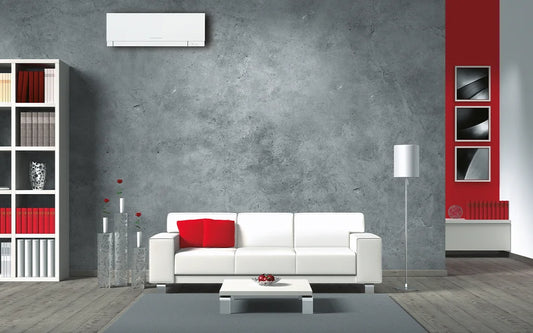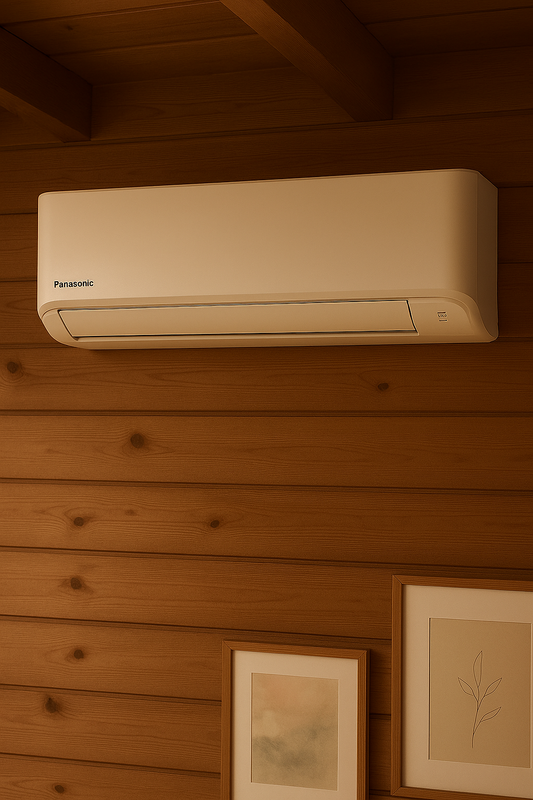Installera Luft-Luft Värmepump Själv: En Guide
Att installera en luft-luft värmepump själv kan vara en utmanande men givande uppgift för den som är villig att ta sig an projektet. I denna guide kommer vi att gå igenom stegen för att genomföra en sådan installation på ett säkert och effektivt sätt.
Definition och Bakgrund
En luft-luft värmepump är en typ av värmepump som använder utomhusluften som energikälla för att producera värme inomhus. Genom att utnyttja luftens naturliga värmeenergi kan denna typ av värmepump effektivt värma upp ett hem eller en annan typ av byggnad. Den kan också användas för att kyla inomhusluften under varmare månader.
Den här typen av värmepumpar har blivit allt mer populära på grund av deras energieffektivitet och miljövänliga natur. Genom att installera en luft-luft värmepump kan man minska energikostnaderna och minska den totala miljöpåverkan.
Fördelar och Användningsområden
Att installera en luft-luft värmepump själv kan innebära flera fördelar. För det första kan det leda till betydande kostnadsbesparingar jämfört med att anlita professionell installation. Dessutom ger det dig en djupare förståelse för hur värmepumpen fungerar, vilket kan vara värdefullt för framtida underhåll och reparationer.
Luft-luft värmepumpar är lämpliga för användning i både bostäder och kommersiella byggnader. De kan vara särskilt effektiva i områden med ett moderat klimat där temperaturerna sällan når extremvärden.
Relaterade Tekniker, Begrepp eller Variationer
Det finns flera olika typer av värmepumpar, varav luft-luft värmepumpen är en. Andra vanliga typer inkluderar luft-vatten värmepumpar och bergvärmepumpar. Var och en av dessa har sina egna specifika fördelar och användningsområden, och det kan vara värt att överväga vilken typ som bäst passar dina behov innan du tar beslutet om installation.
Vanliga Frågor (FAQ)
-
Kan jag installera en luft-luft värmepump själv om jag inte har tidigare erfarenhet?
Det är möjligt att göra det själv, men det kan vara en komplicerad process som kräver noggrannhet och kunskap om elektriska system. Om du känner dig osäker rekommenderas det att anlita en professionell installatör. -
Hur mycket kan jag förvänta mig att spara på mina energikostnader med en luft-luft värmepump?
Det beror på flera faktorer, inklusive din nuvarande uppvärmningsmetod och energipriserna i ditt område. Generellt sett kan en välinstallerad luft-luft värmepump leda till betydande energibesparingar. -
Hur lång tid tar det att installera en luft-luft värmepump?
Tiden det tar att slutföra installationen kan variera beroende på din erfarenhetsnivå, tillgången på verktyg och utrustning samt omfattningen av installationen. Det är viktigt att ta den tid som krävs för att göra arbetet noggrant och säkert.
Sammanfattning
Att installera en luft-luft värmepump själv kan vara en utmanande men potentiellt belönande uppgift. Genom att förstå de grundläggande stegen i installationen och vara medveten om de potentiella riskerna kan du ta ett informerat beslut om huruvida detta är rätt projekt för dig. Kom ihåg att alltid följa tillverkarens instruktioner och säkerhetsföreskrifter när du arbetar med värmepumpar eller andra elektriska apparater.
Installation Process
The installation process for a DIY air-to-air heat pump involves several key steps. It is important to carefully follow the manufacturer's instructions and safety guidelines throughout the installation. Here are the general steps involved:
- Choosing the location for the outdoor unit
- Mounting the outdoor unit securely
- Installing the indoor unit
- Connecting the refrigerant lines
- Connecting the electrical wiring
- Testing the system for proper operation
Choosing the Right Tools
Having the right tools for the job is essential for a successful DIY installation. Some of the tools you may need include a drill, wrenches, pipe cutter, vacuum pump, and manifold gauge set. It's important to ensure that you have all the necessary tools before starting the installation process.
Common Mistakes to Avoid
While installing a DIY air-to-air heat pump, there are several common mistakes that should be avoided. These include improper refrigerant line installation, inadequate electrical connections, and incorrect unit placement. Being aware of these potential pitfalls can help ensure a smoother installation process.
Case Study: Successful DIY Installation
John, a homeowner with a background in HVAC systems, decided to install an air-to-air heat pump in his home. With careful planning and attention to detail, he was able to successfully complete the installation over a weekend. The heat pump has since provided efficient heating and cooling, leading to noticeable energy savings.
Regulatory Considerations
Before embarking on a DIY air-to-air heat pump installation, it's important to check local regulations and building codes. Some jurisdictions may require permits or professional certification for certain aspects of the installation. Ensuring compliance with these regulations is crucial for a safe and legal installation.
Best Practices for Maintenance
Once the air-to-air heat pump is installed, proper maintenance is essential to ensure its longevity and efficiency. Regular tasks may include cleaning or replacing filters, inspecting outdoor unit coils, and checking refrigerant levels. Following a maintenance schedule can help prevent issues and prolong the life of the heat pump.
Environmental Impact
By utilizing the natural heat energy present in outdoor air, air-to-air heat pumps offer environmental benefits by reducing reliance on traditional heating methods. This can contribute to lower carbon emissions and overall energy conservation. Understanding the environmental impact of this technology can provide additional motivation for DIY installation.
Energy Efficiency Considerations
When selecting an air-to-air heat pump, it's important to consider its energy efficiency rating. Higher efficiency models can provide greater long-term savings on energy costs. Additionally, factors such as proper sizing and installation can impact the overall energy efficiency of the system.
Warranty and Support
Before proceeding with a DIY installation, it's advisable to review the warranty coverage for the air-to-air heat pump. Understanding the terms of the warranty and available support can provide peace of mind in the event of any issues or concerns after installation.
Optimizing Performance
After the installation is complete, optimizing the performance of the air-to-air heat pump may involve adjusting settings for different seasons, utilizing programmable thermostats, and exploring additional features such as zoning capabilities. Maximizing the performance of the system can enhance comfort and energy efficiency.
Additional Maintenance Tips
In addition to regular maintenance tasks, such as filter cleaning and coil inspection, it's important to schedule professional maintenance at least once a year. This can involve thorough system inspection, refrigerant level checks, and performance optimization to ensure the heat pump operates at peak efficiency.
Installation Considerations for Older Homes
For older homes, there may be unique challenges when installing an air-to-air heat pump, such as outdated electrical systems or insufficient insulation. It's crucial to assess the home's infrastructure and make any necessary upgrades or adjustments to accommodate the new heat pump installation.
Financial Incentives and Rebates
Before starting the installation, research available financial incentives and rebates for energy-efficient heating systems. Many governments and utility companies offer programs that can help offset the initial costs of purchasing and installing an air-to-air heat pump, making it a more cost-effective investment.
Remote Monitoring and Control
Some modern air-to-air heat pump models offer remote monitoring and control capabilities, allowing homeowners to adjust settings and monitor performance from a smartphone or computer. Exploring these advanced features can enhance convenience and energy management.
Case Study: Retrofitting an Existing System
In cases where an older heating or cooling system is being replaced with an air-to-air heat pump, careful consideration of the existing ductwork, electrical connections, and space requirements is essential. Retrofitting an existing system requires thorough planning and possibly professional assistance.
Understanding SEER and HSPF Ratings
When evaluating air-to-air heat pump options, it's important to understand the Seasonal Energy Efficiency Ratio (SEER) and Heating Seasonal Performance Factor (HSPF) ratings. These metrics provide insight into the system's cooling and heating efficiency, helping homeowners make informed decisions.
Professional Consultation and Evaluation
If uncertain about the DIY installation process or the suitability of an air-to-air heat pump for a specific property, seeking a professional consultation and evaluation can provide valuable guidance. HVAC professionals can assess the home's unique requirements and offer recommendations for the most effective heating and cooling solutions.
Enhancing Indoor Air Quality
Beyond heating and cooling, air-to-air heat pumps can contribute to improved indoor air quality by continuously circulating and filtering the air. Understanding the impact on indoor air quality can be an important consideration for homeowners seeking comprehensive comfort and health benefits.
Exploring Ductless Options
Ductless air-to-air heat pump systems offer flexibility for homes without existing ductwork or for room-specific heating and cooling needs. Exploring the advantages and considerations of ductless options can provide homeowners with additional installation choices.


